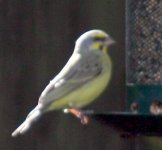Renee Redstart
Well-known member
At about 7.45am this morning, 19th September, in my Northampton suburban garden, I saw an unusual small Finch making good use of my seed feeders. It continued to do so for most of the morning, but I didn't see it this afternoon. I couldn't find it in any of my British or European field guides, but my Ex-beeber friends on BF pointed me to websites with African Green Singer Finches, also known as Mozambique Canaries, on. We think we've ID'd it, (as a male Green Singer Finch) but we would like other people's opinions.
Is it an escapee, or could it possibly be passing through my garden on migration? How do you think it will fare? It didn't sing for its supper, by the way!
I managed to grab a few shots which show its markings very well.
Is it an escapee, or could it possibly be passing through my garden on migration? How do you think it will fare? It didn't sing for its supper, by the way!
I managed to grab a few shots which show its markings very well.











